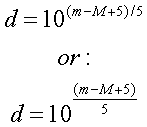Cepheids are a type of
variable star that pulsates
regularly. The properties of
variable stars will be
discussed later, but because these stars have a
particular brightness to variation ratio, they
server as good rulers for determining distances.
By using the Distance Modulus:
m-M=5log10(d)-5
we can determine distance by a
re-write:

If we record a Cepheid variable that
pulsates at a particular rate in some distant
star
cluster or
galaxy, we know the absolute
magnitude
(M) based on the Period-Luminosity relationship. All
we have to do is measure the apparent
brightness (m)
of the recorded Cepheid and plug in the rest. An
example, a Cepheid that pulsates once every three
days
has an absolute (M)
magnitude of -2. Every Cepheid
that pulsates at this rate will have this
magnitude.
RR Lyrae variables can also be used
as rulers, but they pulsate faster and have about a
1
magnitude variation in
brightness. The benefit is
they seem to reside mostly in
globular clusters.
As far as data, the
AAVSO has a
Light Curve Generator that can help determine
the exact data required to accurately solve this
equation.
Back to Top
|

